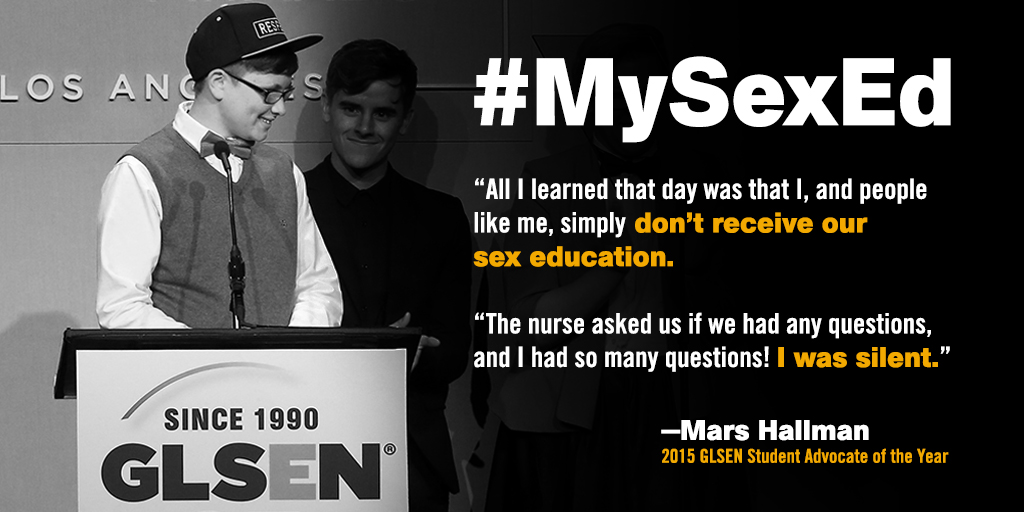A CALL TO ACTION FOR YOUTH, PARENTS, COMMUNITY MEMBERS, EDUCATORS AND POLIC

Lesbian, gay, bisexual, transgender, queer and questioning (LGBTQ) youth need and deserve to learn in settings that are inclusive of their experiences and that give them the education necessary to stay safe and healthy. Far too many LGBTQ youth are sitting in classrooms where their teachers and textbooks fail to appropriately address their identities, behaviors and experiences. Nowhere is this absence more clear, and potentially more damaging, than in sex education.
Each one of us can help change this.
Youth
Become an advocate for inclusive sex education. LGBTQ youth and allies can speak to school health advisory committees (SHACs), school boards, school administrators and teachers about the need for sex education programs that meet their needs. Some SHACs include student members, so consider joining to advocate for inclusive curricula. School clubs, such as Gay-Straight Alliances, can also play a role in educating peers and advocating with educators at school for inclusive sex education. When possible, organize other people to advocate with you. Consult Youth Activist’s Toolkit from Advocates for Youth for more ideas. GLSEN and the Gay-Straight Alliance Network also have many resources to help build or strengthen Gay-Straight Alliances.
Parents and Community Members
Find out what is being taught in your local schools. Many people have no idea whether their schools are providing abstinence-only-until-marriage education, sex education programs that are non-inclusive or truly inclusive programs.
Become an advocate. The way that decisions about sex education curricula are structured vary by school district but there is generally a school health advisory committee that helps oversee curriculum choice. Parents and other community members can speak to school health advisory committees (SHACs), school boards, school administrators and teachers about the need for LGBTQ-inclusive sex education programs. When possible, join the health advisory committee to help positively influence curriculum decisions.
Talk about sex with your own children. Learn about parent-child communication techniques and talk to your own children about the range of gender identities and expressions, as well as healthy sexuality and relationships. Advocates for Youth has a comprehensive guide to help parents through difficult conversations and Planned Parenthood has a section on its website with tools for parents.
Educators
Develop and implement LGBTQ-inclusive sex education curricula. Educators should incorporate best practices for LGBTQ inclusion in sex education curricula delivered in schools, community settings and online. Resources for developing inclusive programs include your local Planned Parenthood affiliate, Answer’s professional development workshop, LGBTQ Issues in Schools, and “Responsive Classroom Curriculum for Lesbian, Gay, Bisexual, Transgender, and Questioning Students” in Creating Safe and Supportive Learning Environments: A Guide for Working with Lesbian, Gay, Bisexual, and Questioning Youth and Families.
Promote inclusivity throughout the school experience. The more that LGBTQ topics are discussed in the classroom and visible on campus, the better it is for LGBTQ youth. It is safe to assume that you have LGBTQ students in your class, whether you know it or not. Support or help students start affirming student organizations like Gay-Straight Alliances. Ensure an early and integrated approach to all LGBTQ issues by talking about LGBTQ people in history, using examples of same-sex couples in math word problems, and using terminology that acknowledges different family structures and gender identities. For more ideas on creating inclusive classrooms, consult GLSEN’s LGBTQ-inclusive Curriculum Guide for Educators and lesson plans on bullying, bias, and diversity.
Policymakers
Remove legal barriers. Policymakers are in a unique position to create change and clear legal roadblocks to LGBTQ-inclusive sex education. Federal, state and local policymakers should work to address gaps and remove restrictions in the policy landscape, requiring sex education that goes beyond disease or pregnancy focus and is truly LGBTQ-inclusive. Policymakers can also support funding for effective sex education and resources for teacher training, program evaluation and research.
Here are some additional resources:
